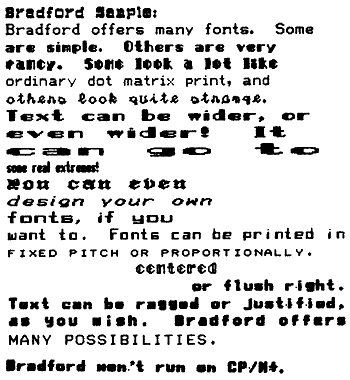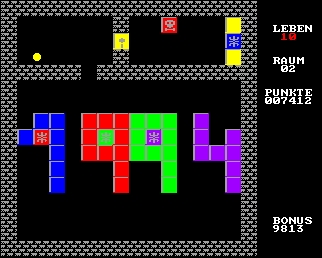- Details
- Geschrieben von Super User
- Hauptkategorie: Magazines
- Kategorie: CFOG's PIP
- Veröffentlicht: 30. November 1987
- Zugriffe: 25129
CFOG's PIP, August 1987, Volume 5 No. 10, Whole No. 58, page 6
Bradford: A Fancy Printing Tool
[This is one of a number of articles which will appear in PIP in coming months that have come from the newsletter of the Bay Area Micro Decision Users group, called BAMDUA. BAMDUA president Rick Charnes and editor Georgia Babladelis have been kind enough to offer exchange of newsletters and disks, so that we don't have to rekey these articles.
This review of Bradford, by an author identified in the Editor's note at the end only as "Dan", appeared in the June 1986 issue. The editor's comments that appear at the end of this review (not in italics) are those of the BAMDUA newsletter editor, Georgia Babladelis. -- bhc]
Program: Bradford Creator: Aaron Contorer Availability: Public Domain, partially Cost: $15
Bradford is a text formatting/printer driver program that turns a cheap dot matrix printer into a near-letter-quality printer. Bradford will team-up with PrintMaster to form a very attractive couple. While PM was for the bigger, splashier side of graphics, Bradford makes use of the printer's graphics mode to form different fonts in 5 sizes. Bradford is not a text editor or word processor. The text is created with any editor. Commands are entered in the text; the mnemonics are the same or similar to WS. Because not all text editors use WS commands, the command character can be changed. It can print with fixed-space or proportionally spaced characters. Bradford makes two passes for each line of print; the first pass lays down mostly the vertical elements, the second lays down the horizonal elements. This allows for more dots, closer together. The darkness of the printing is controlled by the number of times Bradford makes the two passes; three is the practical maximum.
The program, written in Turbo Pascal, is available in CP/M and MSDOS. Mine is version 1.2 and includes 8 fonts (6 of which are NLQ; 1 is draft, normal print; another imitates old dot matrix printers.) Boldface can be set to 3 intensity levels. Underline is good. Both use imbedded control characters ^B and ^S. This can be changed for other editors.
Four types of printers can be used: Epson FX & RX, Gemini 10X & 15X, Epson MX with Graftrax & IBM dot matrix, and Gemini X emulating Epson MX. Even though Gemini Xs are considered Epson FX compatible, the Epson FX selection will not work. [Let's get this straight: the Gemini Xs are Epson compatible with text, but not graphics. Bradford is a graphics mode program. -- bhc] Sorry, Okidata users. Initially, my Gemini would not properly print the boldface but Emma's would. She identified the problem as different DIP switch settings. Changing the buffer full switch to "off" corrected the problem.
BRADFORD's author, Aaron Contorer, initially tried to sell the program for $39.00 mailorder plus $3 p & h. His financial rewards were disappointing. So Contorer decided to retain the rights but put it into public domain distribution and charge $15 for the 18 page instruction manual. With the free instructions Aaron gives, you can print most text files with a choice of one of the fonts and rudimentary formatting; i. e., formatting or no formatting [margins or no margins, numbered or un-numbered pages]. With only these instructions, it would be almost impossible to do serious work with the program. This is an innovative way to market a program: letting others do the distribution and promotion. The customer can even try it out. Just shows -- "You can't judge a progam by it's price."
The printer output is as good as probably can be achieved from these 9 pin printers. The formatting is versatile and extensive -- even as far as I could determine without the manual. The major drag for me is the long list of questions that must be answered each time the program is run, 16. The answers are checked for validity and most do not require <return>. Once started, Bradford insists you answer all questions; there is no cancelling until the last question. I could not bomb the program or cause it to abort while printing. Control-C will abort the printing. Only 5 of the 8 fonts are on the menu. Numbers 1 to 8 can be entered. [There are later releases with more fonts, though they are not listed in the menu. -- bhc]
Hard disk users rejoice! User areas are recognized for text. The font definitions must be in the same user area as the COM file. There should be an install program to eliminate most of the initial questions. [This is the most frustrating aspect of Bradford. Even though you may have set all the relevant parameters with commands inside the file you still have to enter answers to a series of questions, even though the answers will be over-ridden by the commands in the file! -- bhc]
It is not possible to print a part of the text.
Each line can be centered individually. Each font can be made from 1/20th to 5/20ths of an inch. As far as I can determine without the manual, different fonts and sizes cannot be mixed on the same line.
If an erroneous command is entered in the text, Bradford displays a message and prints with the default or ignores the command. It does not abort the printing. It took about 14 minutes to print this file on the Gemini 10X. The last line of a paragraph can end far left or centered or fully justified if the paragraph is fully justified. This is done with your defined unprinted ASCII characters.
Included with the CP/M version are two text files designed to demonstrate Bradford's features. These files are the Rosetta Stone for usefully using Bradford for free. Examine the commands and the printed results; change the commands and see the subsequent results. Print the files with QLIST to see the commands [WS/NW will not print dot commands.] (You could move each dot command over 1 space with find and replace.) [WS will print dot commands: answer the question "Ignore print formatting" wilh a "y", and that's what you will get. -- bhc]
I spent evenings experimenting with combinations, recording the results on paper to make my personal documentation. This is not a good way to save $15.22. I found it to be a worthwhile intellectual exercise. I discovered commands not in the text file based on the author's excellent mnemonics and observance of WS commands. Lastly, in greed for knowledge, I dumped the COM file with EDFILE to find more commands. Some that I found, I still cannot work. After another night of systematic search, I'll probably end up paying the money to check my research.
[The $15 is well spent IF you have the irrerpressible urge to get near letter quality printing of a sort from your 9 pin dot matrix printer and you are in no hurry to get the print job done. Contorer has put a lot of work into this program, and deserves the price he asks, IF this is what you really want. CP/M users ought to be a bit less cheap about supporting programmers and they would see more new software! -- bhc]
Photocopy reproduction tends to smooth the curves and fill in the irregularities. Of the 6 NLQ fonts, the roughest is "italics". I don't consider it NLQ. Rough italics is better than no italics at all. Double or triple strikes make some improvement. The larger sizes reveal the dots more; the rounder fonts, "vanilla and italics" reveal the dots at the rounded corners and diagonals. I have seven daisy wheels for my Dynax, at $25 each that won't do all the things this program will do. There is not much more to learn than you already know from WS/NW. Therefore, it is vastly easier than FancyFont. The price is much easier too. If you have only a dot matrix printer of the types mentioned and no daisy wheel send Aaron 15 bucks; you'll be glad you did!
[BAMDUA Editor's Note: I have tried this program and agree with all of Dan's comments, including that about the irritation of going through all the questions every time. A way to configure the program for repeated items (such as type of printer) would be nice. Even handier would be a command asking if you want to repeat running Bradford or exit, with the possibility of editing one or more of the answers already given. For example, if all you want to do is change the name of the file you want to print, or the character width of the print, then it would be a godsend not to have to go through the long list of questions again. The manual does describe how to mix fonts and character widths in the same line, and it is quite simple to use. If you are used to WordStar or NewWord, the commands for this program will be easy for you to use. It is a good program and does produce near letter quality print on my Gemini-10X printer. Because of the number of strikes required to do so, it is a slow way to print -- but probably not slower than a good many daisy wheel printers nor other programs permitting font changes and near letter quality printing on a dot matrix printer. This is by far the least expensive program of this nature that I know of, but it is not as versatile as FontStar which is reviewed in this issue also].
Bradford is in the CFOG library. There are some simple starting directions provided in the doc file, but the best thing to do is to get the manual. Just send a check for $15 to Aaron Contorer, Concom Enterprises, 1521 Central Avenue, Deerfield, IL 60015.





